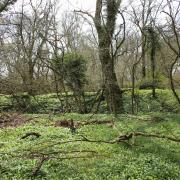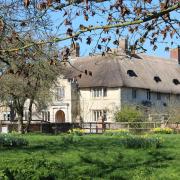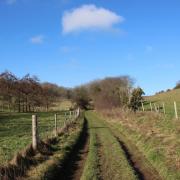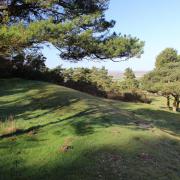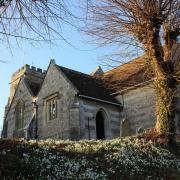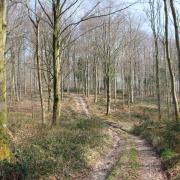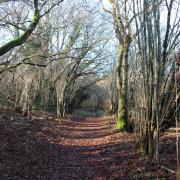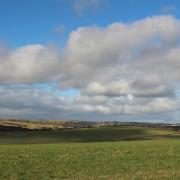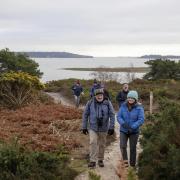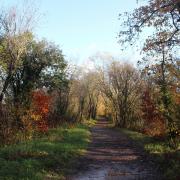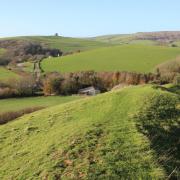Discover the fascinating churches at Trent and Nether Compton, as well as the two historic village pubs of The Griffin's Head and The Rose and Crown Inn, in this lovely summer ramble with Dorset magazine's walks writer Edward Griffiths
Charlock Hill is a long and winding escarpment which rises to nearly 500ft and shelters the villages of Trent and Nether Compton from the worst of the easterly winds. This fine walk takes in these charming villages, both blessed with elegant churches and some truly exquisite houses and cottages built from the local Ham Hill stone. Surrounding, is the most glorious countryside, with low valley fields and high ancient woods, crossed by a lattice of ancient tracks, worn deep by centuries of continuous use by travellers, traders and itinerant workers.

The two churches on this walk are exceptional, each being the centuries-old centre point of its own village and each with a rare carved chancel screen which separated the people in the nave from the priest performing his rites in the chancel.

During the Reformation, most churches’ chancel screens were removed so that the congregation could participate more in the services. Trent’s 13th-century St Andrew’s Church had its chancel rebuilt in the 15th century, and still has its ornate carved oak screen.

Nether Compton’s 13th-century St Nicholas’ Church was much altered in the 15th century, when its tower was added, but the carved stone chancel screen was listed only as ‘modern’ in 1952. It seems odd that ceremonial was separated from the people once again in modern times.

The Walk
1 Before leaving, visit St Nicholas’ Church. Notice the sundial on the west tower and the ‘modern’ stone chancel screen inside. The lead-lined font is 14th century. Then, with the green right, walk down the street away from St Nicholas’. The village’s charming stone cottages mostly date from the 17th century, including those opposite the green. Pass the left turning signed ‘Over Compton’ and ‘Yeovil’ with Old Police House right. Continue, with a right stream, to the T-junction with The Griffin’s Head, built in 1599.

Turn left. As Crossfields bends right, keep straight on, signed ‘Bridleway Trent Mill ½’, into the tree-lined, gently rising cobbled track, then descending slowly as the track narrows and meanders through trees. Possibly a little muddy after rain at the bottom alongside the left stream. Reaching a T-bend, with a two-way ‘Bridleway’ sign, Trent Mill is down the left bridleway but turn right up the hedged lane, rising gently.

2 In ¼ mile, after some left sycamores, take the left footpath-bridge. Into the wide field, cross to the right end of the facing thatched Rose and Crown Inn which dates from the early-18th century.

Over the footpath-stile/1½ gates, go past the inn to the road. Turn right. Pass left St Andrew’s raised churchyard and The Chantry next door.

At the tree-shaded triangle, notice the gate-piers onto the drive to Trent Manor House which is medieval but altered in the 17th century. When the future Charles II was defeated at Worcester in 1651, the 21-year-old tried to escape to France from Lyme and this is where he was hidden from pursuers during his flight to freedom. Go through the half-gate to pass behind The Chantry, built in the late-15th or early-16th century for a chantry priest of the church.

At St Andrew’s, there’s a sundial on the buttress against the staircase door by the south porch. Notice Church Farm’s 18th-century barn over the wall behind the west tower. The gable end’s carved head corbels are distinctly ecclesiastical. Now, continue along the lane, passing the large originally 15th-century Rectory right and Turners Close Almshouses. These were built in 1846 with an ornate octagonal well-head in the yard. Here, turn right into Down Lane, signed ‘Sherborne 4’ and ‘Village Hall’.

3 Follow the lane, with the left stone-slab pavement, a blend of houses and the school, passing left Fisher’s Close and right Trent Memorial Hall 1914-1919. Most original Trent cottages are 17th century including the next left bend’s twin-gabled Manor Farm House with the date-stone ‘1660’. Continue along Down Lane past left Abel’s Lane, left ‘High Pavement’, right Mill Lane and left Rigg Lane until the pavement ends at an S-bend with side lanes branching off. With Plot Lane right and a pond on the left corner, keep straight on into the sunken, rising and hedged lane. This becomes a track at the right thatched cottage. Now, Charlock Hill is spread out ahead and right.

4 Note the ‘Keep Dogs on Leads’ sign for the protection of game and wildlife. The track becomes more deeply sunken as it rises. At a right bend with a left gate, keep to your bridleway-signed track. Soon, surprisingly, there’s a short descent to a gates’ crossing but then, under trees, start slowly ascending again, grassier now. Reaching a sharp right bend, ignore the left bridleway half-gate which leads walkers, somewhat exhaustingly on a hot summer’s day, to the top of Charlock Hill. Keep to the hedged track around the bend, rising a little more steeply to another sharp right bend. From here, the track runs along Charlock Hill’s lower slopes. It may undulate but it’s generally downhill from now on.

5. Notice Yeovil suburbs ahead, but this is the right way. Pass a left bridleway-signpost and continue down, more steeply, stony and sunken. Ignore all side gates and a right grass track. There is a probably-muddy section of track, but it’s firm underfoot where the water rivulet flows. Emerge into Nether Compton at right Folly Cottage then continue, with right stream and ford, around a left bend and onto The Griffin’s Head. Turn left and walk back to St Nicholas’ church where you started.

Compass Points
Distance: 3½ miles/5.5 km
Time: 2½ hours
Exertion: Easy to moderate. Two gentle ascents. Damp patches on route possible after heavy rain.
Start: St Nicholas’ Church, Nether Compton. Park thoughtfully alongside the green (Grid Ref: ST598173)
Map: OS Landranger Sheet 183
Public Transport: South West Coaches X11, First Bus 58, 58A and X10
Dogs: On leads where there is livestock or ground nesting birds (abide by The Countryside Code), through villages
Refreshments: The Griffin’s Head, Nether Compton and The Rose and Crown, Trent
Click here for a Bronze Age Dorset walk at Winfrith Heath





